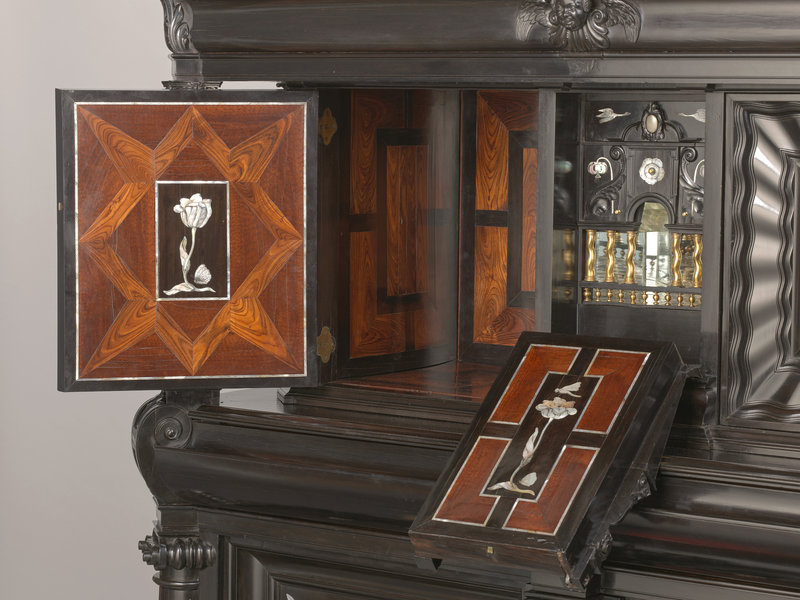Rijksmuseum acquires monumental ebony cabinet inlaid with mother of pearl masterwork by Herman Doomer
Cabinet, Herman Doomer, 1632. Rijksmuseum.
AMSTERDAM.- A rare cabinet by the Netherlands’ leading cabinetmaker of the 17th century was recently acquired by the Rijksmuseum and goes on display from tomorrow in the Gallery of Honour. Made in 1632, this ebony cupboard with mother-of-pearl inlay by Herman Doomer was in private hands for several centuries. It is believed to be Doomer’s first masterwork, and the only piece by him that can be accurately dated. This cabinet will be displayed alongside another by Doomer that has been in the Rijksmuseum collection since 1975. Both will remain on show in the Gallery of Honour until 14 March 2023.
"This magnificent 17th-century ebony cabinet is a testament to how ahead of his time Herman Doomer was, and a monument to his abilities. We are most grateful to the players of the Friends Lottery and donors for making this acquisition possible.",Taco Dibbits, Director of the Rijksmuseum
Cabinet, Herman Doomer, 1632. Rijksmuseum.
Herman Doomer
Herman Doomer (c. 1595-1650) was the leading cabinetmaker in the Netherlands in the 17th century. Born in Anrath, Germany, he settled in Amsterdam in 1613. Doomer introduced new styles and techniques to cabinetmaking, and the two rare pieces by him in the Rijksmuseum collection are exceptional examples of these developments.
Rembrandt
We know that Rembrandt was a great admirer of Doomer’s work. Like the painter, the cabinetmaker lifted the arts in Amsterdam to new heights. Rembrandt painted portraits of Herman Doomer and his wife Baertje Martens in 1640. These paintings now hang in the Metropolitan Museum of Art in New York and the Hermitage in St Petersburg.
Cabinet (detail), Herman Doomer, 1632. Rijksmuseum.
Baroque innovation
The recently acquired cabinet bears witness to Doomer’s search for a new style. While the lower section is fairly traditional, in the upper section the cabinetmaker introduced movement and Baroque innovation, such as in the fan-shaped ripple and twisted columns. The cabinet is inlaid with costly ebony wood and radiant mother-of-pearl – a combination that was entirely new to Amsterdam. The other Doomer cabinet in the Rijksmuseum collection was made several years later, by which time baroque was firmly established.
Cabinet (detail), Herman Doomer, 1632. Rijksmuseum.
Restoration
The Rijksmuseum’s furniture renovators have thoroughly restored the cabinet. Where necessary they reconstructed mother-of-pearl elements and removed and re-attached the ebony veneer. This conservation work followed the findings of research into the methods Doomer used to make the cabinet.
Cabinet (detail), Herman Doomer, 1632. Rijksmuseum.
The Rijksmuseum’s furniture restorers will be present in the Gallery of Honour on the first Thursday of each month throughout the display period. They will shed light on the restoration process and show visitors the interior of the cabinets. From 16:00 onwards on Thursday 1 December, 5 January, 2 February and 2 March.
Restauration Cabinet, Herman Doomer. Photo: Rijksmuseum/Kelly Schenk
Restauration Cabinet, Herman Doomer. Photo: Rijksmuseum/Kelly Schenk
Restauration Cabinet, Herman Doomer. Photo: Rijksmuseum/Kelly Schenk
Restauration Cabinet, Herman Doomer. Photo: Rijksmuseum/Kelly Schenk

/https%3A%2F%2Fprofilepics.canalblog.com%2Fprofilepics%2F1%2F0%2F100183.jpg)
/https%3A%2F%2Fstorage.canalblog.com%2F03%2F02%2F119589%2F96711876_o.jpg)
/https%3A%2F%2Fstorage.canalblog.com%2F11%2F31%2F119589%2F94773502_o.jpg)
/https%3A%2F%2Fstorage.canalblog.com%2F20%2F83%2F119589%2F94772815_o.jpg)
/https%3A%2F%2Fstorage.canalblog.com%2F26%2F72%2F119589%2F75604929_o.jpg)
/https%3A%2F%2Fstorage.canalblog.com%2F59%2F60%2F119589%2F26458628_o.jpg)











/image%2F1371349%2F20240409%2Fob_4f7d28_2024-nyr-22642-0904-000-a-small-jichim.jpg)
/image%2F1371349%2F20240409%2Fob_1dca7b_2024-nyr-22642-0901-001-a-small-longya.jpg)
/http%3A%2F%2Fstorage.canalblog.com%2F33%2F52%2F119589%2F129430751_o.jpg)
/http%3A%2F%2Fstorage.canalblog.com%2F90%2F15%2F119589%2F128553990_o.jpg)